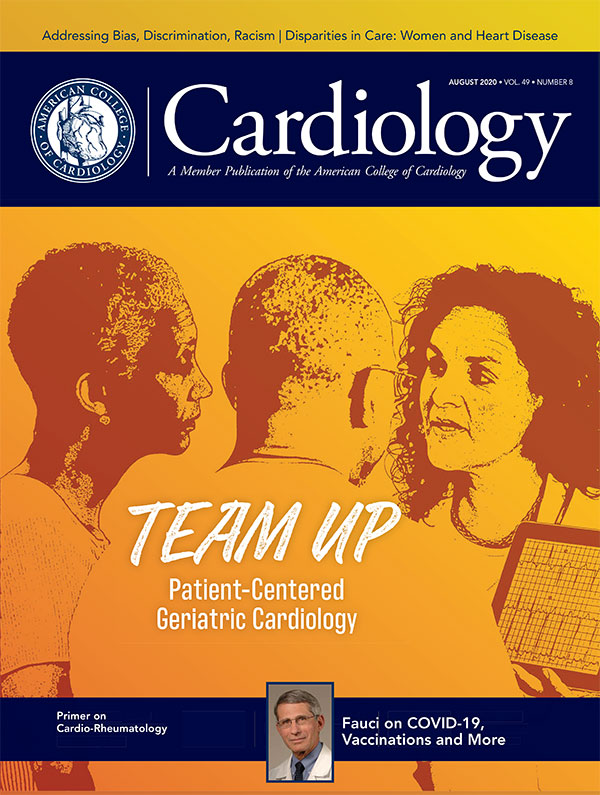Feature | EuroPCR e-course 2020: Top Interventional Takeaways

EuroPCR continued the shift to virtual conferences, and their e-course delivered the usual phenomenal meeting with notable interventional trials and hotline topics. I would like to thank all the health care providers and organizers of the meeting for their hard work to continue to bring new science for the field of interventional cardiology.
I'll start with the trial I was personally waiting for – looking at bioprosthetic valve in valve (ViV) implantation. The number of aortic ViV procedures are increasing, because of bioprosthetic valve degeneration. However, there are no data on long-term outcomes after aortic ViV.
Data have finally come through the VIVID Registry that assessed the durability of the bioprosthetic ViV and long-term outcomes after transcatheter implantation. Survival was lower at eight years in patients with a small (≤20 mm) vs. large (>20 mm) failed bioprosthesis. Pre-existing severe prosthesis–patient mismatch, device malposition, age and balloon-expandable bioprosthetic valves were independent correlates for all-cause reintervention.
The FABOLUS FASTER trial examined the effect of tirofiban compared with cangrelor on the inhibition of platelet aggregation (IPA) in patients presenting with STEMI who received potent oral P2Y12 inhibitors (prasugrel). STEMI patients were randomly allocated (1:1:1) to cangrelor (n=40), tirofiban (n=40), both administered as a bolus and 2h infusion followed by 60 mg of prasugrel, or 60 mg loading dose of prasugrel (n=42).

The findings of this study were interesting. After 30 minutes of administering the medication, cangrelor did not achieve noninferiority in the comparison with tirofiban, which yielded superior IPA over cangrelor (IPA, 95.0 vs. 34.1; p<0.001). Both cangrelor and tirofiban were superior to chewed prasugrel. Furthermore, there was no difference in the effect on IPA for patients who received a prasugrel tablet vs. those who received chewed prasugrel. Despite the small number of patients in this investigator-initiated, open-label randomized trial, it still answered many clinical questions related to patients presenting with STEMI.
Moving along in the coronary space, there's an interesting study that I think could change the way we practice and use coronary functional testing. A pooled analysis of the patient-level data from the DEFINE FLAIR and iFR SWEDEHEART trials provide new insights on two-year outcomes of patients whose revascularization was deferred based on the fractional flow reserve (FFR) or instant wave-free ratio (iFR) measurements.
Similar outcomes were found for patients with intermediate lesions whose revascularization was delayed because of functional testing and those who were not. This finding provides reassurance that regardless of the type of coronary functional testing being used in your cath lab, both FFR and iFR perform the same in terms of guiding decision-making for performing or deferring PCI.
Among patients in the deferral group, for patients younger than 60 years, the decision was based on FFR in 42% and on iFR in 54% (p<0.01). However, for patients 60 years and older, there was a more even split, with 46% and 48% being deferred because of the FFR and iFR, respectively (p=NS). The authors noted that with age as vascular function begins to change at about age 60 years, the response to adenosine decreases steadily, so hyperemic flow is much higher in younger patients than in older patients, while baseline flow remains the same. Thus, FFR, vs. iFR, may be guiding younger patients to more PCI, and iFR may be the first choice for functional assessment in patients <60 years old.
Turning to patients with stable ischemic heart disease (SIHD), a systematic review and meta-analysis of 14 randomized trials with a total of 14,877 patients found that after a mean follow-up of 4.5 years, routine revascularization was not associated with improved survival, vs. an initial conservative strategy. But routine revascularization was associated with a lower risk of nonprocedural myocardial infarction (MI) and unstable angina, with greater freedom from angina at the expense of higher rates of procedural MI. A result similar with that from the ISCHEMIA trial. The message continues to be the same: patients with SIHD should be treated medically before considering revascularization.

Coronary chronic total occlusions (CTO) was the focus of my next pick. A post hoc analysis of DECISION-CTO evaluated the five-year outcomes of PCI vs. CABG in a large cohort of patients with CTO and multivessel disease. At five years, after adjustment via inverse probability of treatment weighting, the primary outcome favored the CABG group for all-cause mortality, cardiac mortality, MI, repeat revascularization and target vessel revascularization.
Although this analysis addresses an important clinical question, we must be mindful of some limitations of DECISION-CTO, including early termination and follow-up, which limits the power of the trial, the high rate of crossover (close to 20%) from medical management to invasive therapy, and the uncertainty regarding the viability of the myocardium before revascularization.
Staying in the complex coronary space, DEFINITION II showed a systematic two-stent technique was associated with better outcomes compared with a provisional stenting approach in patients with complex coronary bifurcation lesions. At the one-year follow-up, target lesion failure was lower in the two-stent technique vs. provisional technique. Double-kissing crush stenting was used in 77.8% of patients assigned the two-stent technique. However, the incidence of cardiac death was not significant in either group.
TRILUMINATE assessed the efficacy and safety of the TriClip transcatheter tricuspid valve repair system. It found a low incidence of major adverse cardiac events and all-cause mortality and significant quality of life improvements in patients with moderate to severe tricuspid valve regurgitation. These patients had improvement in NYHA class I-II from 31% to 83% post intervention. This is a new step forward for transcatheter options for patients with moderate to severe tricuspid valve regurgitation who are deemed at high surgical risk.
Clinical Topics: Invasive Cardiovascular Angiography and Intervention, Stable Ischemic Heart Disease, Vascular Medicine, Interventions and Structural Heart Disease, Interventions and Vascular Medicine, Chronic Angina
Keywords: ACC Publications, Cardiology Magazine, Middle Aged, Adenosine, Uncertainty, ST Elevation Myocardial Infarction, Coronary Occlusion, Platelet Aggregation, Bioprosthesis, Incidence, Tricuspid Valve Insufficiency, Quality of Life, Percutaneous Coronary Intervention, Fractional Flow Reserve, Myocardial, Hotlines
< Back to Listings


